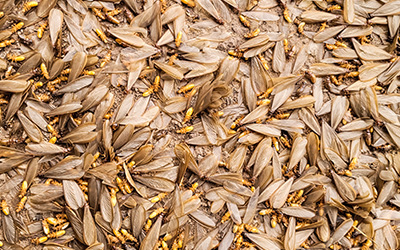Most people who live in a termite-infested house could stay for decades before realizing they have a problem. Until the insects cause severe enough damage to become visible—or homeowners invest in a termite inspection, usually while trying to sell the house—it’s almost impossible to tell if termites are feeding inside of your walls.
Discovering a termite infestation years after it’s started can be incredibly stressful (not to mention expensive!). If you have a hunch that you may have wood-destroying insects near your house, it’s best to tackle the problem head-on with quality termite control services. Here’s what homeowners should know about termite prevention, removal, and treatment.
Types of Termites in Florida
Florida is home to several species of termites, each with its own unique characteristics and behaviors. Some of the most prevalent termite species found in Florida include:
Eastern Subterranean Termites
Eastern subterranean termites are the most common and destructive termite species in Florida. These termites build their colonies underground and construct mud tubes to access wooden structures above ground. They feed on cellulose-rich materials such as wood and paper, causing extensive damage to homes, buildings, and other wooden structures.
Formosan Subterranean Termites
Formosan subterranean termites are another highly destructive termite species found in Florida. These aggressive termites form large colonies and are capable of causing rapid and extensive damage to wooden structures. They are known for their ability to build massive mud nests and infestations that can be challenging to control.
Drywood Termites
Drywood termites are less common than subterranean termites but can still pose a threat to homes and structures in Florida. Unlike subterranean termites, drywood termites do not require contact with soil and can infest dry wood directly. They often establish colonies within wooden furniture, structural timbers, and other dry wood materials.

Do You Have Termites?
Detecting a termite infestation can be challenging, as these wood-destroying pests typically live entirely out of sight. They don’t just feed on wood; they also burrow deep into it, so their nests can be almost impossible to detect from the outside. That said, keeping an eye out for these common signs of termites can help you identify infestations early on:
- Mud Tubes: Subterranean termites construct mud tubes along foundation walls, crawlspaces, and other surfaces to provide moisture and protection as they travel between their colony and food sources. These tubes may appear as small, irregularly shaped structures clinging to walls or wooden materials.
- Wood Damage: Termites feed on cellulose-rich materials such as wood, paper, and cardboard, causing structural damage over time. Look for signs of wood damage, including hollowed-out or weakened wood, blistering or sagging surfaces, and the presence of sawdust-like frass near infested areas.
- Swarmers: Termite swarmers, or reproductive adults, may emerge indoors or outdoors during swarming season, typically in spring or early summer. These winged termites are attracted to light and may be seen flying around windows, doors, or light fixtures. The presence of swarmers indoors may indicate an established termite colony nearby.
- Discarded Wings: After mating, termite swarmers shed their wings and may leave behind discarded wings near window sills, doorways, or other entry points. Finding piles of wings indoors or outdoors may suggest an active termite infestation nearby.
- Termite Swarms: In the spring and summer when termites mate, winged adults leave the nest to find a partner. This is the time of year when it’s easiest to tell if there’s an infestation nearby; if you notice termite swarmers in your yard, it’s best to call a professional exterminator.
Is it Safe to Live in a House With Termites?
Though termites are not known for biting humans or spreading diseases, they aren’t a houseguest you want around. Not only are they capable of causing unsightly damage by building mud tubes along your walls or chewing through wooden structures, but they can also ruin important structural components of your home. While devastating damage is not typical, common types of termite damage includes:
- Structural: Termites live in the walls and they pass through studs and beams of your home. When this happens, it causes weak points in the wood. Sometimes the timber holding up your home can even feel soft, which is not only a resale problem, but it’s dangerous for you and your family.
- Cosmetic: Termites reproduce in your carpets during the spring, which is already unpleasant enough. However, as they feed and grow their colony, termites can also chew through other wooden belongings like chairs, tables, and more.
- Foundational: Gaps or cracks in your foundation will allow termites to make their way into your home. In large amounts, they can even cause damage to the structural integrity of your house from the ground up.
It may take a colony years to cause dangerous levels of damage, but worst-case scenarios have left houses unstable and unsafe to walk through—not to mention extremely costly to fix. That and a history of termite damage can be a huge deterrent to potential homebuyers, which could make it more challenging to sell your property in the future if you plan to do so.
Termite Exterminators in Tallahassee
If you start to see some of the signs of an infestation, you don’t want to wait around. Termites could cause permanent damage to your property if you don’t take a proactive approach to drive them out—but don’t worry, that’s where Capelouto can help!
Our team of termite exterminators specializes in eliminating infestations for good. No matter how small or severe the colony is, our team will ensure termites aren’t something you need to worry about again. If you want to learn more about our treatment methods or get an estimate, contact us today!
Termite Control Termite and Pest Control in Tallahassee FL
Serving Your Pest Needs for over 50 years in Tallahassee FL
